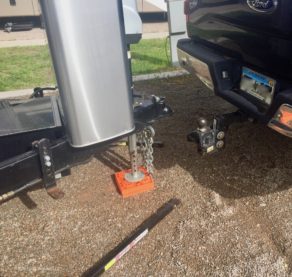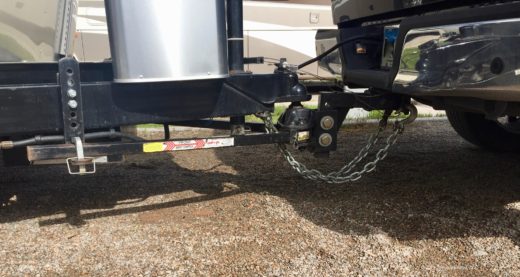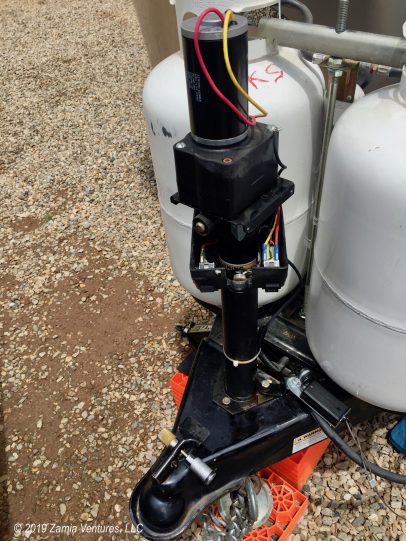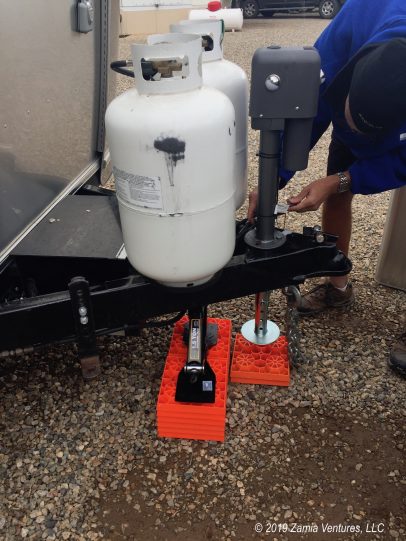We have made relatively few customizations on our rig, and we like to think that’s because we made smart choices up front about what we wanted in a rig before making our purchase. For the most part, we have no regrets about the choices we made in our original rig configuration and the accessories we have added.
Hitch
The weight of our rig is approximately 7,500 pounds when fully loaded with water, food, and our belongings. Based on the specifications of our truck, and general common sense, this means that safe towing requires a weight distributing hitch. (CampAddict has an excellent description of the necessity for weight distribution hitches.) Again, for reasons of safety and common sense, we also wanted sway control. We went with the recommendation of our Airstream dealer — who sold both Equal-i-zer and Hensley hitches at the time — and installed the Equal-i-zer hitch.
Once we figured out the process, hitching has become a fairly simple operation. While normally we both participate in hitching, which makes for a much quicker process, we can each hitch up individually.
In general, we’ve been pleased with the hitch. When we initially used the hitch, we were resigned to the very loud creaking sounds that it made as we turned. The camp host at one of our first sites gave us the helpful tip to grease the top and bottom of the brackets into which the spring bars are inserted (but nothing else, since the anti-sway function relies on friction) and this solved the noise problem nicely.
We also find that some campsites are too unlevel or curved for us to attach the spring bars, creating an awkward angle between the truck and trailer. This problem is easily solved by just towing on the ball alone to the dump station or another level area in the campground and attaching the spring bars there before hitting the road.
Jack
Our Airstream came with a factory-installed electric jack, which is necessary to lift up the nose of the A-frame to place it over the hitch ball and also to lift the joined hitch up to install the hitch spring bars. The tongue weight of our trailer alone — the downward force exerted by the tongue on top of the hitch ball — is around 900 pounds, so in theory the 3,000 pound factory-installed jack should have been sufficient. However, hitching up with a weight distribution system requires lifting up the hitched trailer and tow vehicle to allow the spring bars to slide into place. Over time, our hitching process exceeded the capacity of the factory-standard electric jack and it failed on us, as detailed in this post. Our replacement hitch is the Husky Brute 4500, and it’s been a dream.
Power Systems
Our house electricity is powered by two 80 amp-hour absorbent glass mat (AGM) batteries, and we are still using the original batteries that came with the rig when we purchased it in April 2017. When we are connected to shore power, the external electricity feed obviously keeps our batteries fully charged and also powers a few outlets directly.
When not plugged into power, we mostly rely on solar power. We have two 80-watt rooftop solar panels that were factory installed on the rig, which also came with a factory-installed solar charge controller and battery monitor. In addition, we use a 120-watt portable panel from Zamp that has its own built-in solar charge controller and plugs directly into our battery pack. PV solar electricity production is notoriously finicky, and just the shadow of a single branch across a corner of a panel can substantially degrade output. Since we can move the portable panel out of the way of shade much easier than we can relocate the entire rig, we find that our portable panel actually generates more power than our 160-watt rooftop system.
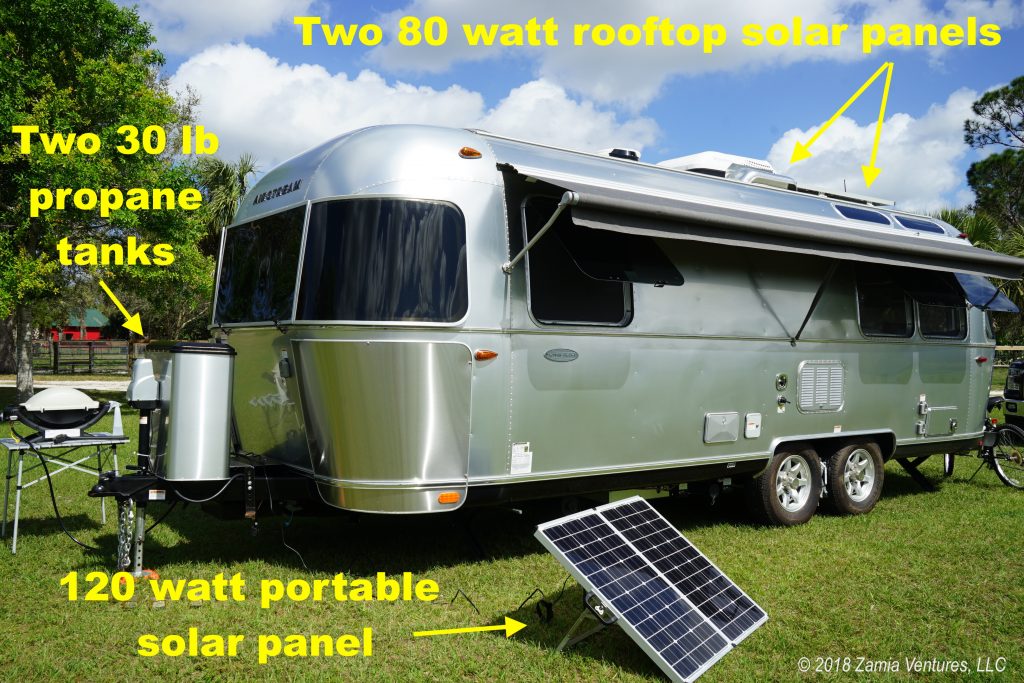
Since the sun doesn’t always shine, and sometimes we are in places with deep shade, we also carry with us a super quiet 2000-watt Honda generator. We probably pull that out only a few times per year, but it’s still absolutely necessary as a backup.
We find that we can manage just fine off the grid for extended periods of time, in large part because our rig is optimized for energy conservation.
- We do all our cooking with propane. We do not have a microwave installed in the Airstream; instead we have a propane oven for baking and a propane cooktop for regular cooking. We also have a quick connect from our propane line to our grill.
- When we are not connected to shore power, our refrigerator runs on propane. When we are connected to shore power, it switches automatically to run on electricity.
- Our Airstream came from the factory with all LED lighting, except for halogen lights in the stove hood which we never use.
- We do not have the ability to run our air conditioning without shore power. We manage this by spending summers in cooler places, like the Rocky Mountains of Montana and Colorado.
- The rig’s core systems all run on 12v direct current. In order to make alternating current we must turn on our inverter. When not connected to shore power, we limit inverter use based on the conditions for solar power generation. For example, we charge our laptops once per day and rarely use the TV when not on shore power.
Tanks
Our rig has a 39-gallon fresh water tank which we use for all our water needs from cooking to drinking to washing. We double filter our cold water with an external filter on our water hose and an in-line water filter under the sink. We have only had one issue with bad water, and it was the result of filling our tank with a family member’s well water during a hurricane evacuation, so our options were limited. Sanitizing the water system after we discovered the problem was fairly easy (once we got the right length of sewer hose) and we sanitize all our water lines with bleach about once a year.
We also have two six-gallon plastic water jugs that we can use to fill the rig manually, which effectively extends our fresh water tank. We are sure to bring in full jugs of extra water when camping in spots without access to water like remote desert camping.
Our rig also has a 37-gallon grey water tank that holds waste from the sinks and shower. Our black tank, for toilet waste, holds 39 gallons. We’ve become accustomed to conserving water in our daily life activities like cooking, dishwashing, and brushing our teeth, so we know can easily go a week between tank dumps without even bothering to check our tank levels or implementing any special measures. After just one week, we will be below 50% on both our black and grey tank levels. Given this, we can of course make it two full weeks between tank flushes. However, if we we are planning to go two weeks between dumps we will work to limit the burden on the tank by cooking one-pot meals, for example, and doing more cooking on the grill.
While we have lots of room in our 25-foot interior and could happily exist in a shorter rig, one of the big reasons for our size selection was the size of the tanks. Smaller Airstreams generally come with smaller tanks, which could limit our maximum stay.
